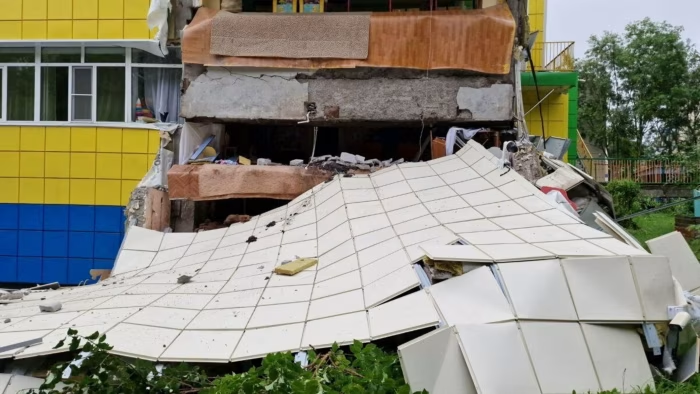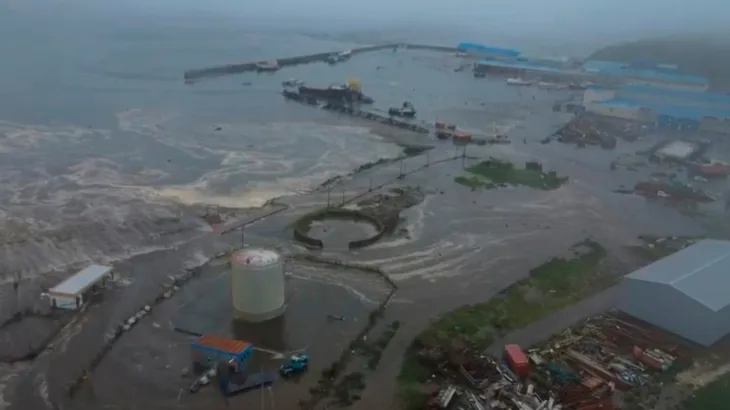8.5 Magnitude Russia Earthquake Sparks Tsunami Panic | Live Alerts in US, China | Warnings Issued in California, Washington, Hawaii
A powerful 8.5 magnitude earthquake near Russia triggers tsunami warnings across the Pacific. Live updates as alerts are issued in California, Washington, Hawaii, China, and Japan. Stay informed with real-time developments
Russia Earthquake, Tsunami LIVE Updates: An earthquake of magnitude 8.8 – one of the world’s strongest-struck Russia’s far Eastern Kamchatka Peninsula early on Wednesday, generating a tsunami of up to 4 metres (13 feet), damaging buildings, and prompting evacuation warnings in the area several areas in Japan and the United States. “Today’s earthquake was serious and the strongest in decades of tremors,” Kamchatka Governor Vladimir Solodov said in a video posted on the Telegram messaging app, adding that a kindergarten was damaged due to strong tremors.
The first tsunami wave hit the coastal area of Severo-Kurilsk, the main settlement on Russia’s Kuril Islands in the Pacific, according to the local governor, Valery Limarenko. A tsunami with a height of 3-4 metres (10-13 feet) was also recorded in parts of Kamchatka.

A tsunami wave of about 30 centimetres (about 1 foot) also reached Nemuro on the eastern coast of Hokkaido, according to the Japan Meteorological Agency. Trenours also set off a tsunami in the northern Pacific region and prompted warnings for coastal areas of Alaska, Hawaii, Chile, the Solomon Islands and south toward New Zealand. Waves of more than 3 meters (yards) were possible along some coastal areas of Ecuador.
The quake was about 119 kilometers (74 miles) away from the Russian city of Petropavlovsk-Kamchatsky, which has a population of 180,000, on the Kamchatka Peninsula.
A massive 8.5-magnitude earthquake struck off the eastern coast of Russia on Tuesday, triggering widespread tsunami warnings across the Pacific Ocean, with alerts issued in parts of the United States, China, Japan, and several other nations. The quake was centered off the Kamchatka Peninsula, a seismically active zone frequently hit by undersea earthquakes.
According to the United States Geological Survey (USGS), the earthquake occurred at approximately 11:42 AM local time, with the epicenter located in the northwestern Pacific Ocean, at a depth of about 40 kilometers (25 miles). The tremor was powerful enough to be felt hundreds of miles away, and authorities quickly issued tsunami advisories for nearby and distant coastal regions.
Following the quake, the Pacific Tsunami Warning Center (PTWC) swiftly issued tsunami alerts for several countries. The most affected zones currently under watch or warning include:

United States (West Coast) – California, Oregon, Washington, and Hawaii
Japan – including coastal regions of Hokkaido and Honshu
China – eastern provinces like Zhejiang, Fujian, and Guangdong
South Korea and Taiwan – advised to stay alert
Emergency sirens were heard across Honolulu and Hilo in Hawaii, while coastal towns in California such as Santa Cruz, Monterey, and Los Angeles began evacuation protocols for residents near the shore. In Washington state, tsunami shelters were opened, and local police issued public warnings advising people to move to higher ground.
Tsunami wave activity has already been recorded in parts of Japan’s northern coast, with waves reaching up to 1.3 meters (4.2 feet). The Japan Meteorological Agency (JMA) has warned of possible larger waves and aftershocks. In Russia’s Far East, initial tsunami waves were also observed near Petropavlovsk-Kamchatsky, with officials urging coastal evacuation.
The US National Weather Service (NWS) confirmed tsunami waves could reach up to 3 meters (10 feet) in some US coastal areas, particularly in Hawaii and Alaska, depending on the underwater topography and distance from the epicenter.
As a precaution, commercial flights over the North Pacific are being rerouted. Airlines such as Delta, United, and Japan Airlines have issued advisories and delays. Ports in Vladivostok, Shanghai, and Honolulu have suspended operations temporarily. Several container ships have been advised to move further out to sea.
Emergency agencies across the Pacific are on high alert, with live bulletins being updated regularly. The Federal Emergency Management Agency (FEMA) in the US has activated coastal response units, and China’s Ministry of Emergency Management has raised its threat level to orange.
“This is a potentially dangerous situation,” said a spokesperson for the PTWC. “Communities along the Pacific coastlines must follow instructions from local authorities and evacuate if advised.”
Read Also : Gold Prices Rebound from 3-Week Lows — Experts Predict Stronger Demand in Q4 2025 and Beyond








